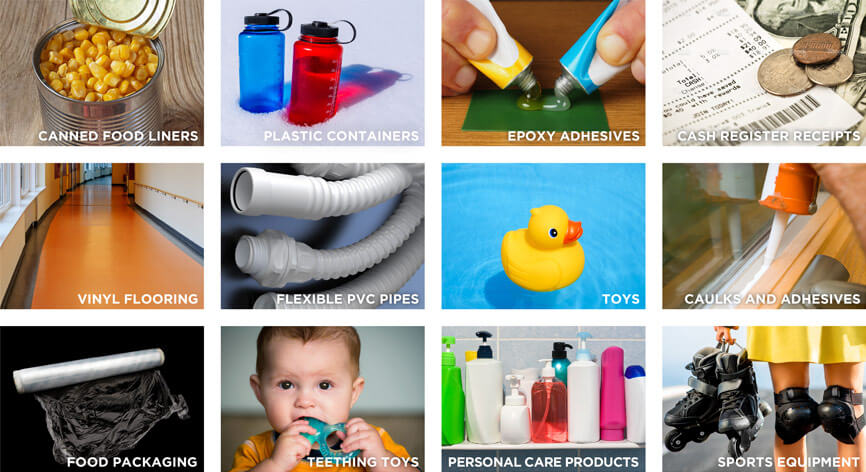Bisphenols & Phthalates
Are they disrupting our hormones?
What are bisphenols and phthalates?
Bisphenols and phthalates are chemicals that have many uses, including making plastics stronger or more flexible. Learn what you can do.
How are we exposed?
Bisphenols and phthalates leach from products into food, water, and dust. Humans are primarily exposed through eating food or drinking water stored in containers made with them. We are further exposed through ingesting and inhaling dust and through skin absorption. Bisphenols and phthalates have been detected in the urine of most people tested. For more information about how you can avoid contact with chemicals, visit our exposure page.
What are the concerns?
Bisphenols and phthalates are often:
TOXIC: Harmful to humans and ecosystems. Even at low levels, bisphenols and phthalates can mimic or block hormones, disrupting vital body systems in humans and wildlife.
Early life exposure to Bisphenol A (BPA) is linked to asthma and neurodevelopmental problems such as hyperactivity, anxiety, depression, and aggression. In adults, BPA exposure is associated with obesity, type 2 diabetes, heart disease, decreased fertility, and breast and prostate cancer.
Prenatal and early life exposure to phthalates is linked with asthma, allergies, and cognitive and behavioral problems. It may also affect reproductive development in boys. In adult men, phthalates are associated with reduced fertility.
UBIQUITOUS: Present throughout the environment and our bodies. Bisphenols and phthalates are often called “everywhere chemicals” because they are used so widely and are continuously leaching into the environment.
How do you say the word “phthalate”?
Phthalate is pronounced “THA-layt.” These compounds are derived from phthalic acid. Many harmful phthalates are known by (easier to pronounce) acronyms:
- Di-n-butyl phthalate (DBP)
- Di(2-ethylhexyl)phthalate (DEHP)
- Diethyl phthalate (DEP)
- Di-n-octylphthalate (DNOP)

When should bisphenols & phthalates be used?
When certain bisphenols and phthalates are phased out of products, they are often replaced with other bisphenols and phthalates with similar properties and even less health information. Manufacturers should therefore look for alternatives outside of this chemical class. And for both health and environmental reasons, industries should be moving away from petroleum based plastics when possible.
What is being done?
There has been limited federal action on bisphenols and phthalates. In 2008, Congress passed the Consumer Product Safety Improvement Act which bans eight phthalates in toys and children's products. In 2012, the FDA banned one bisphenol (BPA) in baby bottles, sippy cups, and infant formula cans.
More comprehensive state action has helped move the needle. For example, state policies have led to phthalates being removed from children’s toys and BPA being removed from most plastic bottles nationwide.
What can you do?
- When possible, opt for glass, porcelain or stainless steel containers and tableware, particularly for hot food or liquids.
- Avoid microwaving plastics.
- Avoid plastic products marked with recycle codes 3 or 7, which may be made with bisphenols or phthalates.
- Eat more fresh food and less canned, packaged, and fast food.
- Avoid handling cash register receipts. If you do touch a cash register receipt, wash your hands afterward.
- Look for fragrance-free personal care products. The words “fragrance,” “perfume,” or “parfum” often mean phthalates are present.
Watch our short introductory video on bisphenols and phthalates. Learn about safer products on our consumer resources. Discover how to limit toxic chemicals in your life on our exposure page.
Videos
Bisphenols & Phthalates: Four-minute introduction
Dr. Carol Kwiatkowski on Bisphenols & Phthalates
